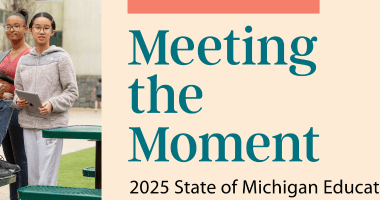Making progress toward equitable funding for underserved students will necessitate big strides
By Amber Arellano, Executive Director, The Education Trust-Midwest
When it comes to improving education in Michigan, we have such a long way to go toward creating opportunities for every student that even big steps forward can feel like baby steps.
It’s true that Gov. Whitmer and lawmakers have worked together to raise overall per-pupil spending in Michigan in recent years, and their bi-partisanship commitment to education should be celebrated. And we are pleased that Gov. Whitmer’s proposed budget makes advances in acknowledging the longstanding funding disparities that have disproportionately impacted economically-disadvantaged students and those with greater needs.
Yet unfortunately, the fact remains that Michigan has been one of the worst states in the nation for fair and equitable funding as compared to leading education states.
That’s why it’s imperative that lawmakers adopt key provisions of Gov. Whitmer’s proposed education budget that move the needle toward a more fair and equitable funding system that the Michigan Partnership for Equity and Opportunity coalition and its bi-partisan statewide leaders have championed for the last year. The Education Trust-Midwest is a proud backbone organization of the coalition.
After all, Michigan has long had one of the most unfair, regressive school funding formulas in the country. National research has shown that historically and on average, Michigan’s highest poverty districts have received five percent less state and local funding than Michigan’s lowest poverty districts despite serving a student population with significantly greater needs.
And let’s be clear: even with progress that Gov. Whitmer is proposing to make in terms of K-12 education investment, the state’s school funding system is far from fair and equitable.
Indeed, if we are truly committed to supporting our most underserved students and closing devastating opportunity gaps, we need to be honest about what constitutes fair funding in our state — and we need to make much bigger strides for the students who most need investment. Black and Latino students, in particular, have been the hardest hit by the pandemic learning losses and need investment for their educational recovery in the coming years.
First, state leaders should support Gov. Whitmer’s proposal to remove budget language that effectively balances the budget on the backs of low-income students by cutting from their funding first when there’s a budget shortfall. Changes include permanently striking this phrase in Sec 31a (14) that requires cutting at-risk funding first before overall cuts.
This is critical because, as our organization’s analyses have shown, this unfair budgetary practice has been used in many of the past budget cycles, a tactic that harms students with the greatest needs, stripping them of funding and resources that they need.
Second, state leaders should commit to fully funding students who are considered at-risk every year. As it stands now, the budget annually calls for allocating 11.5 percent more per-pupil funding for students considered at-risk. Yet, Michigan rarely gets to that level – and the state’s weighted allocation of 11.5 percent is far below the amount that leading states provide to students with the greatest needs.
In fact, as we noted in a report last fall, these students have not received the full funding that the state budget has prescribed in many of the past years, amounting to millions of lost dollars for students with the greatest needs. Coalition partners from the Michigan Partnership for Equity and Opportunity have strongly advocated for the state to provide greater funding for these students.
Currently, the governor’s budget calls for $746.5 million for economically disadvantaged students, which amounts to 11.5 percent of the base per-pupil amount per student, or full funding of that line item.
And while we support the governor’s recommendation, we also urge state leaders to go further as we look at ways to transform Michigan’s education funding system to be more equitable. Indeed, Michigan should consider the progress of leading education states by providing at least 100% more funding per low-income students.
Finally, we urge state leaders to adopt language that would protect at-risk funding – and funding for English learners — from cuts when there is a shortfall in perpetuity.
It is often said that how we choose to spend our money reflects our priorities. The same is true of our state budget.
Sadly, we in Michigan have not prioritized students with the greatest needs for decades. Now is the time to change that dynamic, not with baby steps but with big strides so that we can truly close opportunity gaps that have hindered success for Black and Latino students, students with disabilities, English learners and children from low-income backgrounds.
Let’s start with closing funding gaps so that students with the greatest needs have the funding and opportunities that they deserve to be successful now and in the future. Michigan’s students deserve no less.
This commentary originally appeared in Crain’s Detroit Business.








